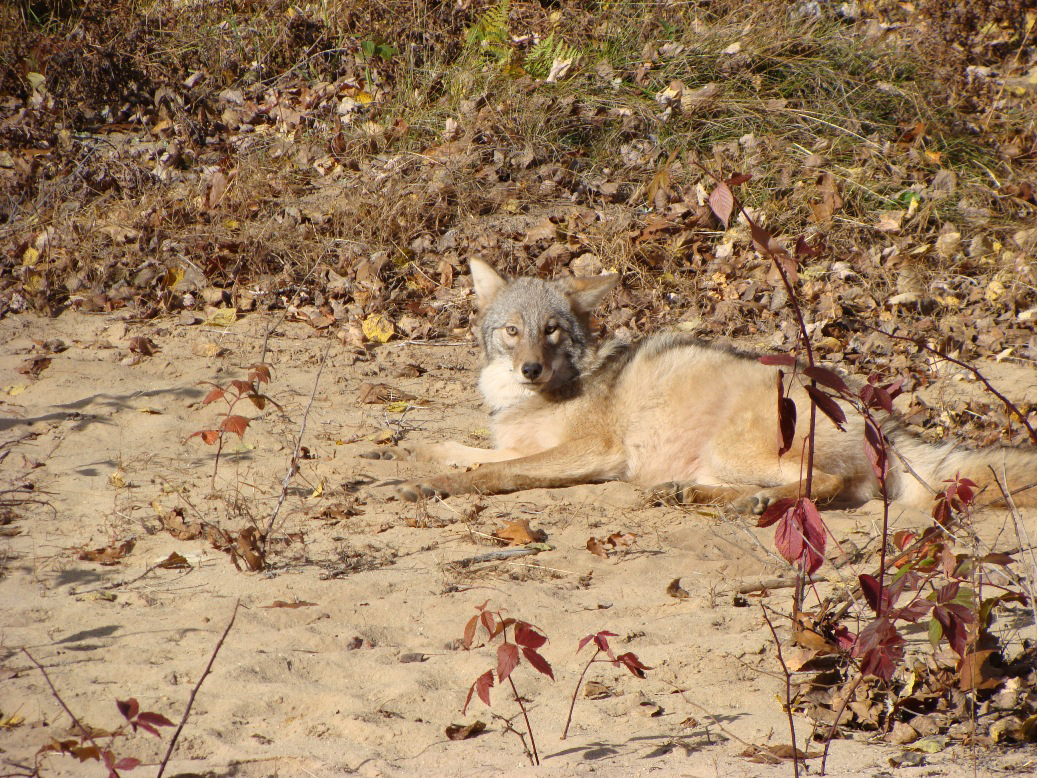![635607447182673352-Coywolf-1[ID=24192843] ID=24192843](http://www.gannett-cdn.com/-mm-/f026597bda51f1ec775c3bdeac3a9cf82224021e/c=402-190-940-650/local/-/media/2015/02/28/DetroitFreePress/DetroitFreePress/635607447182673352-Coywolf-1.jpg) (Detroit Free Press) -- Phil Myers had heard the stories from Cheboygan County farmers: Tales of odd, oversized animals that looked bigger than a coyote, but smaller than a wolf, and hunted in packs — and how strange they sounded.
(Detroit Free Press) -- Phil Myers had heard the stories from Cheboygan County farmers: Tales of odd, oversized animals that looked bigger than a coyote, but smaller than a wolf, and hunted in packs — and how strange they sounded.
He wanted to hear for himself.
Wolves are known to have a rendezvous point where, in the evening, individual wolves that may be sleeping all over get together as a pack to go off hunting, said Myers, a now-retired professor of ecology and evolutionary biology at the University of Michigan. Based at U-M's Biological Station in Cheboygan County, researchers had found dens, and what they thought was a rendezvous point.
So, one night last August, Myers parked his pickup about a quarter-mile from the spot and listened.
"As the full moon goes up above the jackpines, one of these things starts howling — it wasn't the yipping of a coyote or the full voice of a wolf; but a hoarse, sustained call," he said.
"About five minutes later, I hear a bark from my right, then a bark from my left, five or six of them. I was surrounded by them. But this was in forest and swampland; these were no dogs. Those were pack-mates coming into this rendezvous point.
"It was probably at least an hour before the hairs on the back of my neck sat down."
Myers' close encounter was with a unique, still relatively unknown and misunderstood hybrid of coyotes known as eastern coyotes or coywolves. They're mostly coyote, but contain a small percentage of wolf from an unlikely mating of the two species about a century ago. It may sound like an urban legend, but coywolves exist throughout the northeastern U.S. and eastern Canada, and have been confirmed in northeast Lower Michigan through blood-testing and DNA analysis.
![DFP coywolves CREATURE FEATURE PRESTO.jpg[ID=24186741] ID=24186741](http://www.gannett-cdn.com/-mm-/f206c3a358c3f6d0e5dbc620e6b22f54b6cba280/c=302-844-2281-2536/local/-/media/DetroitFreePress/2015/02/28/B9316402830Z.1_20150228175424_000_G3GA36U1F.1-0.jpg) Coywolves tend to be a little larger and heavier than their western coyote counterparts, but still well below the size of even the smallest North American wolves. They look like coyotes, though observers often note wolflike characteristics in their faces and fur.
Coywolves tend to be a little larger and heavier than their western coyote counterparts, but still well below the size of even the smallest North American wolves. They look like coyotes, though observers often note wolflike characteristics in their faces and fur.
Though researchers have determined the range of coywolves — from the Great Lakes east and as far south as Virginia — their numbers and whether their behavior is distinctive from pure coyotes is still largely unknown.
![Michigan DNR ends probe into possible coyote attack on horse[ID=24192895] ID=24192895](/Portals/_default/Skins/PrestoLegacy/CommonCss/images/smartembed.png)
Cheboygan County farmer William Benthem hasn't seen them, but hears the stories from fellow farmers. They believe they're seeing wolves, he said.
"I know too many people who are knowledgeable people who have seen them," he said.
'Eastern coyotes'
Coyote expert Stan Gehrt, a professor of wildlife ecology at Ohio State University, rejects the term "coywolf." He doesn't even like referring to them as hybrids. It leaves the impression that they are a near 50-50 mix of wolf and coyote, and that just isn't the case, he said.
"They are eastern coyotes," Gehrt said. "They aren't really different from other coyotes, other than they have a little bit of genetic difference. I've trapped and tracked hundreds of Midwestern coyotes and a pretty good sample of eastern coyotes in Nova Scotia, and I wouldn't be able to tell the difference between the two."
But those, including biologists, who encountered coywolves up close in the Lower Peninsula say they had some wolflike features.
The animal was discovered in the Pellston and Cheboygan area in 2010, after reports of unusually large tracks in the snow, Michigan Department of Natural Resources wildlife biologist Jennifer Kleitch said.
The DNR and the U.S. Department of Agriculture "became very interested," thinking wolves may have appeared in the Lower Peninsula, Myers said. The last confirmed wolf south of the Mackinac Bridge was in Presque Isle County in 2004, but sightings have been reported since, and the DNR conducts surveys searching for wolves in the northern Lower Peninsula.
Trail cameras were installed in 2010, and some of the photos coming back showed animals that were "wolflike," Kleitch said. A USDA wolf biologist trapped a male pup in July 2010 in Cheboygan County. Blood tests were taken, and the pup was ear-tagged and released.
Later that fall, a coyote trapper caught two half-grown animals, and noticing their difference from typical coyotes, contacted the DNR. As in July, blood samples were drawn and the animals were fitted with radio collars.
"They wanted to see how they were moving, and whether they are a problem for the farmers up there," Myers said.
Kleitch got to see the coywolves that were trapped in October up close. She'd never seen anything like it.
"It was strange," she said. "The nose was a little narrow for a wolf, but the feet were large like a wolf. They were the young of the year and they were females, and the weights on them were about 42 and 49 pounds — that's pretty large for even an adult female coyote."
After tracking the animals' radio signals for several weeks, one of the collars began transmitting a mortality signal, Kleitch said. It was later found cut off and thrown into a ditch. "We presume the animal was poached," she said.
But the other animal is still followed, with the help of Myers' class at the U-M Biological Station, she said.
Meanwhile, the genetic results came in on the three animals' blood tests.
"The animals were all from the same litter, and typed out as coyote rather than wolf," she said. They also had DNA from eastern wolves, the tests showed.
Interspecies breeding
Based on the relatively low percentage of wolf DNA in coywolves, many scientists say the interspecies breeding occurred in the early 1900s, likely in Ontario as western coyotes migrated east from the Great Plains. Some split and headed north of the Great Lakes into Canada; others to the south around Ohio. Based on coywolves' range now, it was a coyote in this northern group, perhaps having no mate of its own species available, that must have mated with a female eastern wolf. It's known that the female in the coupling was a wolf, because the mitochondrial type of DNA exhibiting wolf characteristics is passed on by the female.
The eastward-migrating coyotes that went north of the Great Lakes and interbred with wolves grew and spread in population much more quickly than those without wolf DNA to the south.
Though highly unusual, coyotes, wolves and even dogs have been known to interbreed on occasion and produce viable offspring also capable of breeding.
"Wolves normally kill coyotes; they chase them out of the range," Myers said.
But there is not a scientific consensus that the wolf-coyote coupling occurred long ago and not again. A 2012 study of the blood results of the three captured coywolves in northern Michigan concluded their hybridization could have occurred in the Lower Peninsula "if a recolonizing wolf encountered a coyote and mated with it in the absence of" another wolf with which to breed.
Researchers from the U-M biological station last year tracked radio-collared coywolves, and found their range slightly larger than a typical coyote's but less than a wolf's.
OSU's Gehrt, however, is skeptical. Even if coywolves are observed to hunt in packs and take down larger animals such as white-tailed deer, that's behavior in which conventional coyotes occasionally engage as well, he said. The size of the range is more likely driven by the available food — eastern coyotes he has studied in Nova Scotia have taken down moose because of a lack of other food options, he said.
"The idea that the 5% wolf DNA is having this impact on their morphology and ecology should be held up to some rigorous testing," Gehrt said. "I think it would be more reasonable to presume it's just not going to have that much effect."
Scientists still have a lot to learn about the animals, Gehrt said. Among the areas ripe for study is whether the small percentage of wolf DNA will start working its way into western coyotes, or whether it will be diluted away, he said.
No known attacks
Despite a belief that coywolves are more likely to take down a deer, Myers said he's not aware of any instances of farmers' cattle or sheep coming under attack in northeast Lower Michigan.
Management and regulation of the animals could become complicated. The hybrids — impossible to confirm without DNA tests — are simply treated as coyotes in Michigan.
"Coyotes can be hunted and trapped almost year-round, and wolves right now are endangered, so there's no take," Kleitch said. "It gets pretty sticky.
![Officials warn to keep pets safe as coyotes sightings rise in Beverly ...[ID=24192879] ID=24192879](/Portals/_default/Skins/PrestoLegacy/CommonCss/images/smartembed.png)
"We tell people that if it looks like a wolf, treat it like a wolf. That means if coyote hunters or trappers think it could be a wolf, they should not harvest that animal."
There are two camps of thinking on coywolves, Myers said.
"One is that hybridization is bad, because it dilutes the genotype of the two species that are hybridizing. You'll eventually lose the wolf genotype and the coyote genotype," he said. "But other people feel like places like the Northern Lower haven't had an apex predator for close to 100 years. The deer herd has gotten out of control — the deer hunters don't agree with that; they think that there aren't enough deer. But the numbers, we know, are nowhere near where they were 100 to 150 years ago.
"You're always going to have one group of people who hate them, who have hated coyotes and were absolutely opposed to the growth of the wolf population. And then you've got other people who think it's just kind of cool we're getting a more natural, more balanced ecosystem in the forests up there."
The eastern coyotes are fascinating animals, Gehrt said.
"Indians used to call the coyote the trickster, and say it had the ability to change shapes," he said. "To me, this whole genetic thing is them getting back at us, and living up to their past label as tricksters."
Contact Keith Matheny: 313-222-5021 or kmatheny@freepress.com.
On the wolf — and coywolf — watch in northern Lower Michigan
The Michigan Department of Natural Resources is currently conducting a wolf survey in northern Lower Michigan, looking for public reports of wolf tracks or sightings. Coywolf information is also welcome, DNR wildlife biologist Jennifer Kleitch said.
"We would appreciate getting reports of animals that show wolflike characteristics in the northern Lower Peninsula so we can determine how many and where animals like this may be," she said.
Reports can be made online at http://www.michigandnr.com/wildlife/pubs/wolf_obsreport.asp or by calling the DNR's Gaylord office at 989-732-3541, ext. 5901.


